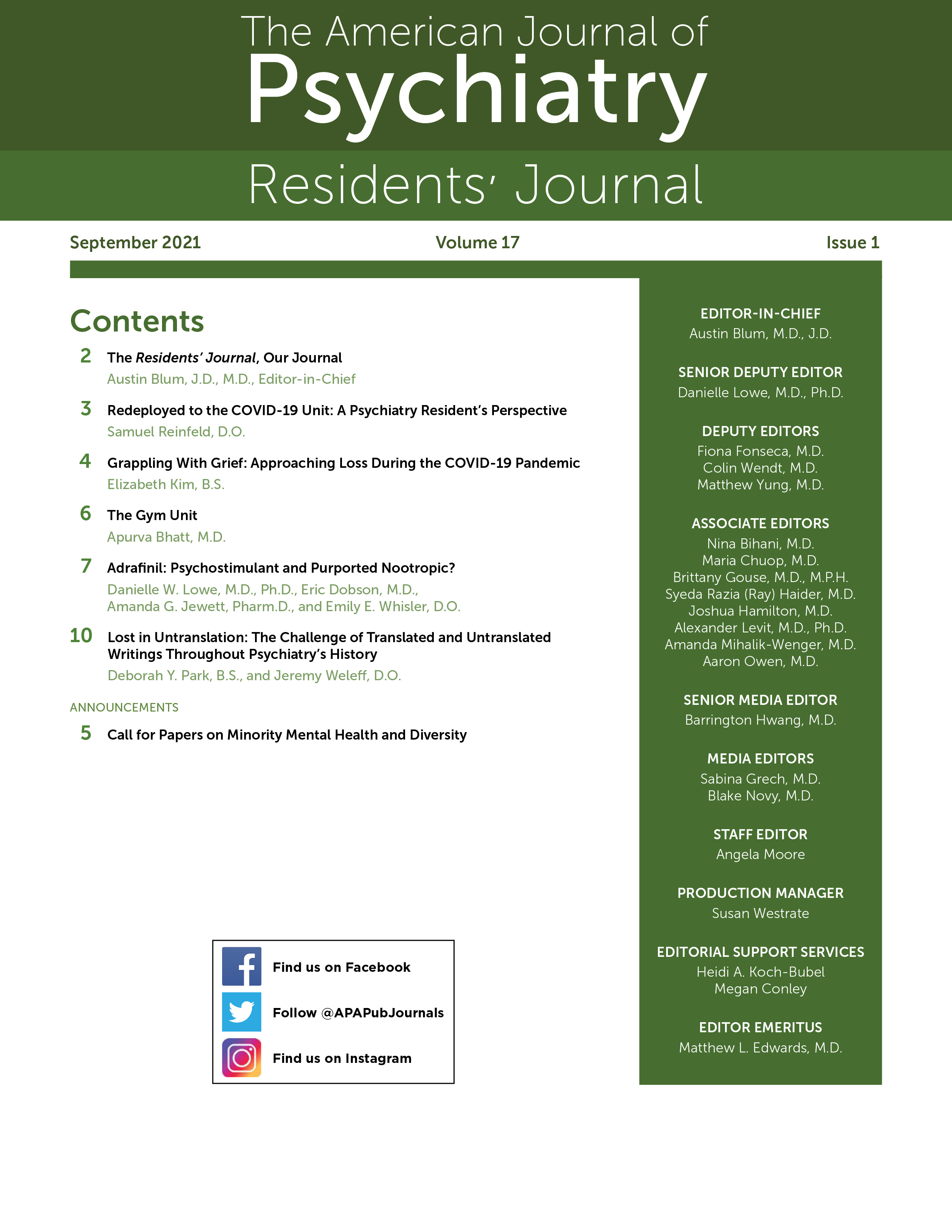Grappling With Grief: Approaching Loss During the COVID-19 Pandemic
As of August 8, 2021, there have been more than 4,265,903 deaths and 200,840,180 confirmed cases of coronavirus disease 2019 (COVID-19) reported by the World Health Organization (1). Individuals are additionally experiencing loss of jobs and loss of connection with the community. With the large number of deaths, the unexpected deaths of previously healthy or young individuals, the lack of traditional bereavement practices, disrupted routines, and disconnected social support systems, there is concern that the COVID-19 pandemic will contribute to an increase in mental health conditions, including prolonged grief disorder. During the COVID-19 pandemic, Robillard et al. (2) have reported increased rates of anxiety and depression in individuals without a prior psychiatric history and worsening of symptoms in those with preexisting psychiatric conditions. Eisma and Tamminga (3) have demonstrated that a recent, personal loss during the pandemic resulted in higher grief severity, compared with a recent loss before the pandemic.
While the COVID-19 pandemic has created an environment in which individuals are susceptible to amplified grief, there are strategies to face this challenging time, particularly, Worden's grief task concept. Worden describes four tasks in the mourning process: accepting the reality of loss, working through the pain of grief, adjusting to an environment in which the deceased or lost is missing, and emotionally relocating the deceased or lost (4). Rather than stages of grief, which implies linearity, or phases of grief, which implies passivity, Worden's task-based framework is beneficial because it focuses on adaptation and active engagement. Because of ongoing changes in the virus itself and a lack of consistently applied guidelines to mitigate the spread of COVID-19, losses of educational and occupational opportunities, as well as participation in social networks, will ebb and flow. Therefore, Worden's approach is advantageous because it creates strategies for confronting and adjusting to various situations, ultimately promoting active progression through loss. It empowers individuals with a sense of action steps and purposeful development. Specifically, Worden explains the task of emotional relocation by motivating mourners to memorialize loss in a manner that prevents further deterioration (4). COVID-19 is changing the world and irreversibly shaping individual lives. Navigating through the mourning process while utilizing emotional relocation encourages recognition of and recovery from the losses faced during this period (see Box 1).
BOX 1. COVID-19 grief experience checklista
Accept the reality of the loss.
Face the fact that a person/place/thing/experience/relationship is gone.
Examples:
If the loss is a death, name the person/people that is/are gone.
Due to physical distancing recommendations, consider hosting or attending a virtual funeral service.
List losses experienced due to the COVID-19 pandemic (employment, social connection, recreational activities).
Process the pain of grief.
It is impossible to lose someone/something you have been deeply attached to without experiencing some level of pain.
Examples:
Describe the painful thoughts and feelings you are experiencing to someone you trust.
Identify ways COVID-19–related losses have resulted in sadness, anxiety, anger, guilt, or loneliness.
Adjust to an environment in which the loss is missing.
Loss can result in a modification in roles, a need to develop new skills, a variation in sense of self, or a change in one's perspective of the world.
Examples:
External adjustments: Explore how COVID-19 has affected your everyday functioning (mask wearing, 6 feet of distancing, cleaning protocols, and temperature screenings).
Internal adjustments: Identify how COVID-19–associated loss has affected your sense of self (occupation, participation in activities you enjoy).
Spiritual adjustments: Describe how the pandemic has affected your beliefs, values, and assumptions about the world (safety, social responsibility, view of authorities).
Emotionally relocate the loss.
Remember a loss, yet stay connected to it in a way that does not prevent you from going on in life.
Examples:
Explain how you will memorialize losses experienced during the COVID-19 pandemic.
Ponder ways that COVID-19 has shaped you and your relationships with others.
a Adapted from Worden's grief task model (4). Before engaging with a task-based approach to the grieving experience, ensure that physiologic and safety needs are met. Although the items are listed in an order, they do not need to be completed in a specific, linear sequence.
The COVID-19 pandemic has caused immense loss globally. Grieving in response to these losses is normal and appropriate; however, the circumstances in which we are grieving are novel. This task-based approach to grief, with emphasis on emotional relocation, will provide a more constructive perspective on the mourning process during this specific pandemic.
1. WHO Coronavirus Disease (COVID-19) Dashboard. Geneva, World Health Organization, 2021. https://covid19.who.int Google Scholar
2. : Emerging new psychiatric symptoms and the worsening of pre-existing mental disorders during the COVID-19 pandemic: a Canadian multisite study. Can J Psychiatry (Epub ahead of print, Jan 19, 2021) Crossref, Google Scholar
3. : Grief before and during the COVID-19 pandemic: multiple group comparisons. J Pain Symptom Manage 2020; 60(6):e1–e4 Crossref, Google Scholar
4. : Grief Counseling and Grief Therapy: A Handbook for the Mental Health Practitioner. New York, Springer, 2018 Crossref, Google Scholar



